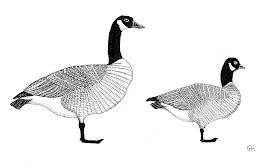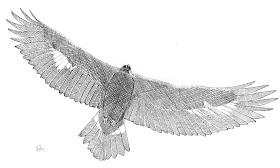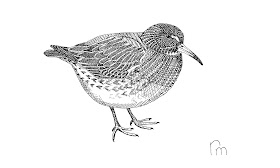This weekend I think I will see a Purple Sandpiper.
The time will be right (late November), the place will be right (the Niagara River), and I received a very positive indication from a fortune cookie today.
Yes, I think it will be a good weekend for birds.
Pages
▼
Thursday, November 29, 2012
Thursday, November 22, 2012
Scoter Time
Hannah & I were in Hamilton last Saturday, birding along the lakeshore with Kevin McLaughlin. We made a number of the regular stops; Hutch's, Gray's Road, Sayer's Park, Green Road, Fifty Point. We saw the typical birds for mid-November; Red-throated Loon, Long-tailed Ducks, Common Goldeneye, all three Scoters. A first-year male King Eider was a highlight.
Most of the ducks were too far offshore for good photographs, but two birds at Sayer's Park were nice and close. One was an adult female White-winged Scoter, and the other a juvenile Surf Scoter.
I thought the above photographs made for a nice comparison. The White-winged Scoter is noticeably larger, with a round head and a gnarly bill shape, while the Surf Scoter is smaller with a flat head and a shorter, more uniform bill shape. The adult males are unmistakable but the juveniles and females require a bit more study. The Surf Scoter shown above has the dark iris and pale lower breast/belly of a juvenile.
White-winged Scoter is one of those birds that has a palearctic population that is sometimes considered a distinct species, and sometimes considered a different subspecies. Either way, I like their name for it better than ours: "Velvet Scoter".
Most of the ducks were too far offshore for good photographs, but two birds at Sayer's Park were nice and close. One was an adult female White-winged Scoter, and the other a juvenile Surf Scoter.
 |
| White-winged Scoter |
 |
| Surf Scoter |
I thought the above photographs made for a nice comparison. The White-winged Scoter is noticeably larger, with a round head and a gnarly bill shape, while the Surf Scoter is smaller with a flat head and a shorter, more uniform bill shape. The adult males are unmistakable but the juveniles and females require a bit more study. The Surf Scoter shown above has the dark iris and pale lower breast/belly of a juvenile.
White-winged Scoter is one of those birds that has a palearctic population that is sometimes considered a distinct species, and sometimes considered a different subspecies. Either way, I like their name for it better than ours: "Velvet Scoter".
Thursday, November 15, 2012
Harlequin Duck
I was at a meeting on Monday near Mavis Rd. and the QEW in Mississauga. This happens to be not far away from Arkendo Park in Oakville where two or three Harlequin Ducks have been seen regularly since Luc Fazio reported them on November 4th.
So after my meeting adjourned, I dropped by Arkedo Park, and in the company of some fellow onlookers I got some fine views of the adult male and lesser quality views of one of the "female" type birds. I put the female in quotes because of a recent article I read in Birding magazine that leads me to believe that first year male Harlequin Ducks might retain a female-like appearance into November. Still, I'll go along with the diagnosis that the bird was a female.
I have only ever seen Harlequin Ducks on large bodies of water, and although I have no complaints about that, I do sometimes wish I could see them in the swiftly flowing rivers and streams where they breed. Broadly speaking there are two populations of Harlequin Duck; a west coast population and an east coast population that breeds in Labrador. Presumably the ones that appear on the Great Lakes in fall and winter are of the eastern population.
So after my meeting adjourned, I dropped by Arkedo Park, and in the company of some fellow onlookers I got some fine views of the adult male and lesser quality views of one of the "female" type birds. I put the female in quotes because of a recent article I read in Birding magazine that leads me to believe that first year male Harlequin Ducks might retain a female-like appearance into November. Still, I'll go along with the diagnosis that the bird was a female.
I have only ever seen Harlequin Ducks on large bodies of water, and although I have no complaints about that, I do sometimes wish I could see them in the swiftly flowing rivers and streams where they breed. Broadly speaking there are two populations of Harlequin Duck; a west coast population and an east coast population that breeds in Labrador. Presumably the ones that appear on the Great Lakes in fall and winter are of the eastern population.
Tuesday, November 13, 2012
"White-cheeked" Geese
Having seen a Cackling Goose in Burlington with Hannah and Cathy this past Saturday, it reminded me of something: in the uncertain realm of taxonomy, there is perhaps no greater conundrum than the "White-cheeked" Geese.
Since 2004, the AOU has formally recognized two species of "White-cheeked" Goose (Canada Goose and Cackling Goose) and the research cited in support of that decision recognized 11 extant subspecies (7 for Canada Goose and 4 for Cackling Goose). However, according to more recent publications, the 2 species/11 taxa approach vastly underrepresents the amount of variety within this population complex. Compare, for example, the approach of H.C. Hanson (2006) which recognizes 6 species and 217 subspecies! Consider also the approach of B.W. Anderson (2010) which recognizes 15 species and 181 subspecies!! It is research like this that leads to misgivings about the essentialist/typological assumptions embedded within birding culture.
 |
| "White-cheeked" Geese (Canada Goose & Cackling Goose) |
Since 2004, the AOU has formally recognized two species of "White-cheeked" Goose (Canada Goose and Cackling Goose) and the research cited in support of that decision recognized 11 extant subspecies (7 for Canada Goose and 4 for Cackling Goose). However, according to more recent publications, the 2 species/11 taxa approach vastly underrepresents the amount of variety within this population complex. Compare, for example, the approach of H.C. Hanson (2006) which recognizes 6 species and 217 subspecies! Consider also the approach of B.W. Anderson (2010) which recognizes 15 species and 181 subspecies!! It is research like this that leads to misgivings about the essentialist/typological assumptions embedded within birding culture.
Tuesday, November 6, 2012
Bills, Bills, Bills
There are a lot of Bills associated with the Hamilton Fall Count. Bill Lamond is the master compiler for the entire count, Bill Wilson is the compiler for the Cambridge Sector of the count, and Bill Read is my count partner. I had an overdose of Bills on Sunday.
Bill and I had fun driving around our count area and getting out periodically to see what could be found. Three Golden Eagles were a highlight (two juveniles/sub-adults & one adult). I think Bill's favourite bird was a Common Loon seen swimming in a pond on the west side of Hwy 24 just south of German School Rd. He did look kind of odd there (the Loon).
 |
| Golden Eagle (sub-adult) |
Bill and I had fun driving around our count area and getting out periodically to see what could be found. Three Golden Eagles were a highlight (two juveniles/sub-adults & one adult). I think Bill's favourite bird was a Common Loon seen swimming in a pond on the west side of Hwy 24 just south of German School Rd. He did look kind of odd there (the Loon).

